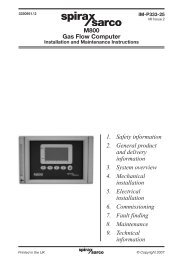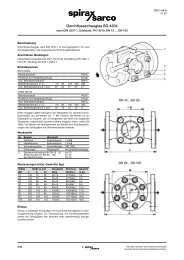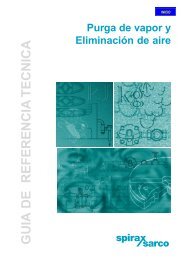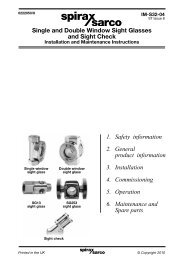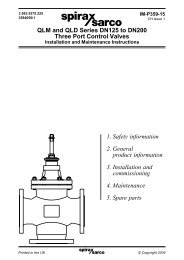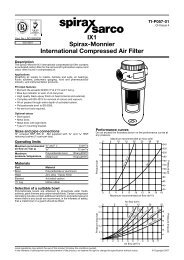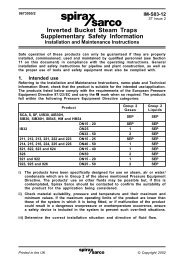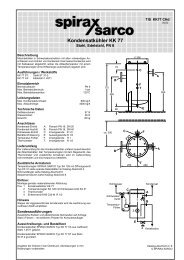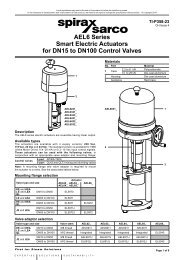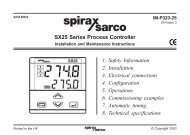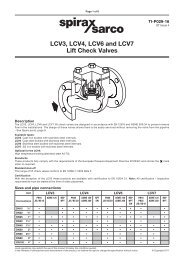2000 Hook-up Book - Spirax Sarco
2000 Hook-up Book - Spirax Sarco
2000 Hook-up Book - Spirax Sarco
You also want an ePaper? Increase the reach of your titles
YUMPU automatically turns print PDFs into web optimized ePapers that Google loves.
SYSTEM DESIGN<br />
22<br />
Parallel and Series Operation of Reducing Valves<br />
This can be clarified by an<br />
example. S<strong>up</strong>pose that a maximum<br />
load of 5,000 lb/h at 30 psi<br />
can be s<strong>up</strong>plied through one<br />
valve capable of passing 4,000<br />
lb/h and a parallel valve capable<br />
of 1,300 lb/h. One valve is set at<br />
29 psi and the other at 31 psi. If<br />
the smaller valve is the one set at<br />
31 psi, this valve is used to meet<br />
loads from zero <strong>up</strong> to 1,300 lb/h<br />
with a controlled pressure at<br />
approximately 31 psi. At greater<br />
loads, the controlled pressure<br />
drops to 29 psi and the larger<br />
valve opens, until eventually it is<br />
passing 3,700 lb/h to add to the<br />
1,300 lb/h coming through the<br />
smaller valve for a total of 5,000<br />
lb/h.<br />
There may be applications<br />
where the load does not normally<br />
fall below the minimum capacity<br />
of the larger valve. It would then<br />
be quite normal to set the 4,000<br />
lb/h valve at 31 psi and to s<strong>up</strong>plement<br />
the flow through the 1,300<br />
lb/h valve at 29 psi in those few<br />
occasions when the extra capacity<br />
was required.<br />
Sometimes the split between<br />
the loads is effectively unknown.<br />
It is usual then to simply select<br />
valves with capacities of 1/3 and<br />
2/3 of the maximum with the<br />
smaller valve at the slightly higher<br />
pressure and the larger one at<br />
the slightly lower pressure.<br />
Two-Stage<br />
or Series Operation<br />
Where the total reduction in pressure<br />
is through a ratio of more than<br />
10 to 1, consideration should be<br />
given to using two valves in series,<br />
Fig. 39 (page 20). Much will depend<br />
on the valves being used, on the<br />
total pressure reduction needed<br />
and the variations in the load. Pilot<br />
Operated controls have been used<br />
successfully with a pressure turndown<br />
ratio as great as 20 to 1, and<br />
could perhaps be used on a fairly<br />
steady load from 100 psig to 5 psi.<br />
The same valve would probably be<br />
unstable on a variable load, reducing<br />
from 40 to 2 psi.<br />
There is no hard and fast<br />
rule, but two valves in series will<br />
usually provide more accurate<br />
control. The second, or Low<br />
Pressure valve, should give the<br />
“fine control” with a modest turndown,<br />
with due consideration<br />
being given to valve sizes and<br />
capacities. A practical approach<br />
when selecting the turndown of<br />
each valve, that results in smallest<br />
most economical valves, is to<br />
avoid having a non-critical drop in<br />
the final valve, and stay close to<br />
the recommended 10 to 1 turndown.<br />
Series Installations<br />
For correct operation of the<br />
valves, some volume between<br />
them is needed if stability is to be<br />
achieved. A length of 50 pipe<br />
diameters of the appropriately<br />
sized pipe for the intermediate<br />
pressure, or the equivalent volume<br />
of larger diameter pipe is<br />
often recommended.<br />
It is important that the downstream<br />
pressure sensing pipes<br />
are connected to a straight section<br />
of pipe 10 diameters<br />
downstream from the nearest<br />
elbow, tee, valve or other obstruction.<br />
This sensing line should be<br />
pitched to drain away from the<br />
pressure pilot. If it is not possible<br />
to arrange for this and to still connect<br />
into the top of the<br />
downstream pipe, the sensing<br />
line can often be connected to the<br />
side of the pipe instead.<br />
Equally, the pipe between the<br />
two reducing valves should<br />
always be drained through a<br />
stream trap, just as any riser<br />
downstream of the pressure<br />
reducing station should be<br />
drained. The same applies where<br />
a pressure reducing valve s<strong>up</strong>plies<br />
a control valve, and it is<br />
essential that the connecting pipe<br />
is drained <strong>up</strong>stream of the control<br />
valve.<br />
Bypasses<br />
The use of bypass lines and<br />
valves should usually be avoided.<br />
Where they are fitted, the capacity<br />
through the bypass should be<br />
added to that through the wide<br />
open reducing valve when sizing<br />
relief valves. Bypass valves are<br />
often found to be leaking steam<br />
because of wiredrawing of the<br />
seating faces when valves have<br />
not been closed tightly.<br />
If a genuine need exists for a<br />
bypass because it is essential to<br />
maintain the s<strong>up</strong>ply of steam,<br />
even when a reducing valve has<br />
developed some fault or is undergoing<br />
maintenance, consideration<br />
should be given to fitting a<br />
reducing valve in the bypass line.<br />
Sometimes the use of a parallel<br />
reducing station of itself avoids<br />
the need for bypasses.<br />
Back Pressure Controls<br />
A Back Pressure regulator or surplussing<br />
valve is a derivative of a<br />
pressure reducing valve, incorporating<br />
a reverse acting pilot valve.<br />
The pressure sensing pipe is connected<br />
to the inlet piping so that the<br />
pilot valve responds to <strong>up</strong>stream<br />
pressure. Any increase in <strong>up</strong>stream<br />
pressure then opens the reverse<br />
acting pilot valve, causing the main<br />
valve to open, while a fall below the<br />
set pressure causes the main valve<br />
to close down, Fig. II-18 (page 92).<br />
These controls are useful in<br />
flash steam recovery applications<br />
when the s<strong>up</strong>ply of flash steam<br />
may at times exceed the demand<br />
for it. The BP control can then surplus<br />
to atmosphere any excess<br />
steam tending to increase the<br />
pressure within the flash steam<br />
recovery system, and maintains<br />
the recovery pressure at the<br />
required level.<br />
The control is also useful in<br />
eliminating non-essential loads in<br />
any system that suffers undercapacity<br />
at peak load times,<br />
leaving essential loads on line.<br />
Back Pressure Controls are<br />
not Safety Valves and must never<br />
be used to replace them.



